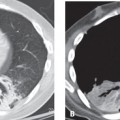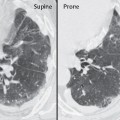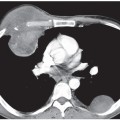CASE 108 42-year-old man, cigarette smoker, with increasing dyspnea for several months HRCT (lung window) (Figs. 108.1A, 108.1B) demonstrates extensive bilateral areas of ground glass attenuation, irregular juxtapleural linear opacities consistent with mild fibrosis, and traction bronchiectasis. Desquamative Interstitial Pneumonia (DIP) • Chronic Hypersensitivity Pneumonitis • Pulmonary Drug Toxicity • Pulmonary Hemorrhage • Eosinophilic Pneumonia Desquamative interstitial pneumonia (DIP) is a rare idiopathic interstitial pneumonia that occurs almost exclusively in current or former smokers and is characterized histologically by diffuse, marked intra-alveolar accumulation of macrophages and minimal interstitial fibrosis. It is considered part of a histopathologic spectrum of smoking-related interstitial lung diseases that includes pulmonary Langerhans’ cell histiocytosis and respiratory bronchiolitis–associated interstitial lung disease (RB-ILD). The term desquamative is a misnomer based on the previous but erroneous concept that the intra-alveolar cells represent desquamated pneumocytes. Some authors have suggested that a more technically correct terminology for DIP would be alveolar macrophage pneumonia. The incidence of DIP is much lower than that of usual interstitial pneumonia (UIP). The diagnosis of DIP requires open or thoracoscopic lung biopsy.
 Clinical Presentation
Clinical Presentation
 Radiologic Findings
Radiologic Findings
 Diagnosis
Diagnosis
 Differential Diagnosis
Differential Diagnosis
 Discussion
Discussion
Background
Stay updated, free articles. Join our Telegram channel

Full access? Get Clinical Tree






